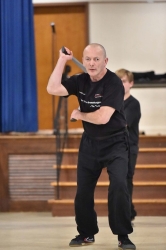
Click, click, click, click…the very melodic sound of double stick training in Dekiti Tirsia Siradas, and that is the topic of this months article.
Baseline
In Dekit Tirsia Siradas, as in all FMA (Filipino martial arts), we want to keep all the moves as practical and combative as possible. However, as with any good art, we must always start with a solid foundation. So, now it is time to incorporate the left hand doing the 12 strikes. Whereas the #1 strike in the right hand will launch off the right side, the #1 strike with the left hand will launch off the left side. This is the approach you should take when practicing with the left side, all strikes launching off the opposite, or reverse side from the traditional right handed grip.
Evolution
Now that we have our solid foundation we can proceed to some rudimentary training drills. In many styles of FMA, when drilling with double bastions they will use a very rhythmic three count (tak, tak, tak), However in DTS (Dekiti Tirsia Siradas), we tend to many times as we evolve our double sticks, use more of a 2+1, (tak tak …tak).
So now let’s begin.
The best place to begin is at the beginning and as they say it is a very good place to start. You can do these drill on a training device (I have a set of heavy bag arm I bought from Century MA), you can do them with a stationary partner holding 2 sticks, or you can do them as a 2 person drill. Shameless plug time, if you follow me on Patreon ($3 monthly), I will have posted all of the versions of the drills there.
Drills
Now remember in DTS, we will not use a broken strike for our attacks, usually only in close quarter fighting as a secondary attack using the punyo (butt of the weapon).
We will start with a #1 right and a #1 left vs the same with a training partner. I like to use a timer set for thirty seconds when I run my basic sets. You can then repeat this off of the #2 strike, the #3 strike, and the #4 strike.
Second set. These sets will be double strikes, starting with the #1 strike and the #2 strike off of the right side and the left, you can also go with the #3 strike to #4 again, right and left. Normally we won’t go off of the #2 or the #4 side first on the drill as getting to the outside of the weapon should be our main intent. Remember, right now we are working medium to long range drills. When we are in close range, countering off of the #2 side is a viable option, however, even in this situation we still want to work our way to the outside gate.
The final one in this series will be to throw the #1 strike to the #2 strike followed by a #1 strike with the off hand, then repeat with the other side. There are actually several ways to do this last set with a partner. The first is to have them hold two sticks stationary at a 90 degree angle, the second is for them to feed you strikes so that you may use your DTS defensive footwork to maneuver to the outside for your counter. First of the right and then of the left. The last would be a two person set where you both will do the movement together at the same time.
Teaching High Six and Heaven Six
Heaven six is a very common drill used in FMA styles, regardless of lineage. Normally we reserve it as a pre-training drill for Espada Data, Long and short blade. I thought today I would share with you my teaching methodology. Start with one stick on the shoulder and the other stick across the body on the hip, both sticks start on the same side of the body. From here one hand and then the other goes, high sake, low strike, high strike. Switch your loading to the opposite side and repeat. Set a timer for 1min and practice, practice. practice
Now move your stick on the hip to the armpit on the same side, all targets will be to the ears or to the top of the head. From the right side will be right hand, left hand, right hand. Then the left side, left hand, right hand, left hand. Set your timer and you’re on your way.
Training with a partner always enhances the experience, so go out there, grab a partner and get started. Train safe, train smart, and have a great day.
EDITOR’S NOTE: For a breakdown of the strikes and techniques used in Dekiti Tirsia Siradas Kali, be sure to check out author Mark Warner’s previous article, The Twelve Strikes of Dekiti Tirsia Siradas. You can also view more of his work here!
- From the editors desk. Did you know we also have a “podcast”? Well, sort of. - October 27, 2024
- General Kwan; Patron Saint of Kung Fu - June 24, 2024
- Dekiti Tirsia Siradas Kali: A Global Martial Art Phenomenon - June 2, 2024

Leave a Reply